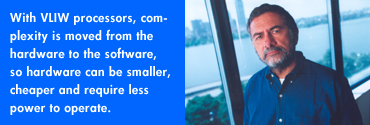
Some inventors trace their career choice to a lifelong passion. HP Senior Fellow Josh Fisher traces his to a single college lecture.
Fisher's epiphany came as a graduate student at New York University's Courant Institute. The person igniting Fisher's passion for computer architecture was a professor — famed computer scientist and mathematician Jack Schwartz.
"Jack told us how computers really worked," Fisher says. "He explained it in a way that was completely different from what I had ever heard. I went from being totally confused and ignorant about the subject to thinking I could build one in one lecture!”
Eager to learn more, Fisher persuaded Schwartz to assign him to work on designing a home-grown replacement for the department's aging supercomputer. When he encountered a difficult hardware problem, Fisher solved it by developing a compiler technique called trace scheduling – now standard in some variation in most compilers for high-performance computers.
Fisher's work on trace scheduling led him to think about a high-performance computer design he later called Very Long Instruction Word (VLIW), which executes many instructions in parallel. He's since gained renown for his pioneering work in this field.
He also broke ground in several research areas beyond trace scheduling and VLIW, including custom-fit, embedded processors.
Fisher joined HP in 1990 to work on VLIW. He founded HP Labs Cambridge in 1994.
"I'm proud that the work I've done in this area has been so successful, bringing the technology to many different products at HP and one of our partners’ (ST Microelectronics) digital video."
Today he is part of a group that is developing a system to do accurate simulation of high-performance computing, commercial computing and enterprise clusters – systems used for compute-intensive applications such as stock trading or bioinformatics.
This system will run real applications and operating systems, and he believes this will help improve HP’s high-performance computing.
Because no one has been able achieve this above the processor level, much of the design work in complex systems is now "back-of-the-envelope," Fisher says. "A simulation system like this would allow us to configure and build systems at lower cost with much higher performance.”
“Building this to be accurate and, at the same time, run real applications and the OS fast enough to be useful, is a sort-of grand challenge," he adds. "I’m looking forward to seeing how successful we can be with this.”
Fisher and former HP Labs Cambridge associate Paolo Faraboschi, who now leads the HP Labs' Barcelona Research Office, recently co-authored (with Cliff Young of D. E. Shaw) a book about embedded computing and VLIW. The book, Embedded Computing: A VLIW Approach to Architecture, Compilers and Tools (Morgan-Kaufman, 2004), is considered both a text book and general reference book.
Previously, Fisher edited and co-authored a chapter in the book, Instruction Level Parallelism, with former HP Senior Fellow Bob Rau, who passed away in December 2002.
Some of Fisher's earlier writing is also noteworthy. When the ACM/IEEE International Conference on Computer Architecture (ISCA) celebrated its 25th anniversary in 1998, it selected the most influential papers in its first 25 years for a commemorative edition. Fisher’s 1983 paper, Very Long Instruction Word Architectures and the ELI-512, was named one of the most influential computer architecture papers in this conference’s history.
Several years later, the ACM/IEEE conference on Programming Languages, Design and Implementation (SIGPLAN/PLDI) did the same, and Fisher's paper, Parallel Processing: A Smart Compiler and a Dumb Machine, was selected.
These conferences are considered the most prestigious in computer architecture and compilers.
When he's not solving complex computing problems, Fisher has an unusual exercise regimen, pursuing a daily session of the Japanese video game Dance, Dance Revolution.
Dance, Dance Revolution involves dancing on a mat, pressing arrows with your feet in a way that is timed to the music and choreographed on a screen.
“People don’t believe this when I say it, but it is the best aerobic exercise I have ever done," says Fisher, who was an avid squash player until Achilles tendonitis kept him off the courts. "The only problem I have is getting myself to stop before I injure myself!"
He also teaches remedial algebra to inner city college students in Miami, where he lives.
“I did this 30 years ago in New York City while earning money for graduate school. I had the sense then that many of the kids I was teaching – they were about my age -- were in a class where they could really catch on to math for the first time in their lives."
Fisher says he's had the same feeling this time around.
"I’m very fortune that the chairman of the math department was willing to take a chance and let me return to this," he says. "I expect to continue to do it as much as I can; it is a source of real pleasure for me.”
|
